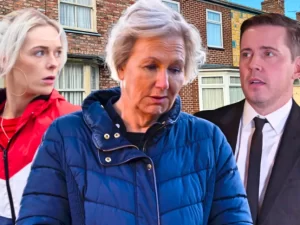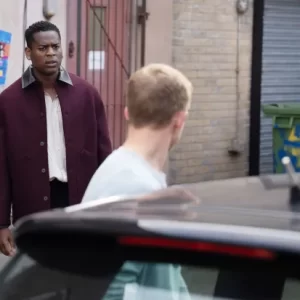Coronation Street is a poignant and emotionally charged film that takes viewers to the heart of love, regret, and the fragile beauty of final moments. In the quaint, storm-weathered streets of Weatherfield, time is running out for Julie Carp, a once-vibrant soul now facing the devastating advance of terminal cancer. Her return to her hometown was supposed to be a chance to reconnect, to forgive, and to be remembered. But fate, as always, has more in store.
Julie, now living with the awareness of her stage four sarcoma, is doing everything she can to fill her final days with meaning. Her sister, Eileen Grimshaw — a woman of stoic loyalty and unspoken pain — has taken it upon herself to make Julie’s remaining time not just bearable, but joyful. Together, the sisters begin to rekindle the bond that life’s distance and distractions had dulled. But joy is fragile when death is near.
Unknown to Eileen, the emotional ripples of Julie’s presence are beginning to erode her personal life. George Shuttleworth, Eileen’s partner, finds himself in a strange emotional limbo. He cares deeply for Eileen, but Julie’s return — and her sheer emotional openness — awakens something long-dormant in him. When Julie casually reveals that Eileen feels stagnant in their relationship, it hits George like a slap. The doubt begins to creep in. Has he become complacent? Is Eileen simply enduring him?
George becomes desperate to prove his love. He plans a romantic evening, hoping to remind Eileen that the spark hasn’t faded — that it’s merely been buried beneath years of routine. But before he can make it happen, a promise is broken. Eileen had arranged a day out at the lake with Julie, a simple but meaningful excursion. George, overwhelmed and trying to balance too much, fails to drive them there as planned. It’s a subtle crack in an already fragile situation.

Forced to take a taxi, Eileen and Julie make the journey on their own. It turns out to be perfect. The sisters share laughter, tears, and a tranquil silence that only the truest of bonds can hold. Julie, though fading, is luminous in this moment — soaking in the view, the wind, the time. She records a video message before they leave, one final love letter to the family she will leave behind. In that message, she gently but boldly tells Eileen to examine her heart, and perhaps, to let go of what no longer serves her — including her relationship with George.
Back at Number 11, George stumbles across the video. The words cut deep. Julie, the dying woman he’s tried so hard to comfort, has essentially given Eileen permission to leave him. He’s filled with sorrow, anger, and confusion. He thought he was doing the right thing. He thought he was supporting both women. Now he’s left wondering whether he was ever truly wanted.
Meanwhile, Eileen remains blissfully unaware of the storm brewing back home. At the lake, she steps away briefly to fetch drinks — and when she returns, everything changes. Julie is gone. No cries, no dramatics. Just a still, peaceful silence. Eileen collapses into grief, her world breaking at the center. The woman who had been her sister, her confidante, her mirror — now just a memory.
The aftermath is quiet but shattering. The Grimshaw family mourns. The house is heavy with sorrow. But within that sorrow, George’s heart is in turmoil. He’s haunted by Julie’s words and unsure of where he now stands with Eileen. Every glance between them is weighed down by everything unsaid. Eileen senses his distance and, in her own grief, begins to snap — frustrated that the man who should be comforting her is instead drifting.
The Last Day Out becomes not just Julie’s swan song, but the unraveling of a long-standing relationship. The beauty of sisterhood, the cruelty of timing, and the question of what we owe each other in love all come crashing together in a heartbreaking, unforgettable final act.
As the credits begin to roll, the image lingers on the lake — its waters still and reflective. A symbol of the peace Julie found, and the emotional waves she left behind. In the end, it’s a story about how we say goodbye — and what comes after the silence.





